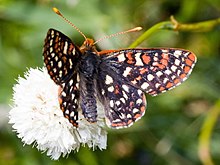| Edith's checkerspot | |
|---|---|

| |
| In Olympic National Park, Washington state, U.S. | |
| Scientific classification | |
| Domain: | Eukaryota |
| Kingdom: | Animalia |
| Phylum: | Arthropoda |
| Class: | Insecta |
| Order: | Lepidoptera |
| Family: | Nymphalidae |
| Genus: | Euphydryas |
| Species: | E. editha
|
| Binomial name | |
| Euphydryas editha (Boisduval, 1852)
| |
| Subspecies | |
|
See text | |
Edith's checkerspot (Euphydryas editha) is a species of butterfly in the family Nymphalidae. It is a resident species of western North America and among the subspecies, entomologists have long been intrigued by their many phenotypic variations in coloration, wing length, and overall body size.[1] Most populations are monophagous and rely on plants including Plantago erecta and Orthocarpus densiflorus as their host species in developing from eggs through to larvae, pupae, and mature butterflies.[2] Males exhibit polygyny whereas females rarely mate more than once. Males devote most of their attention to mate acquisition, and such mate locating strategies such as hilltopping behavior have developed.[3] Climate change and habitat destruction have impacted certain subspecies. Three subspecies in particular, Euphydryas editha quino, Euphydryas editha bayensis and Euphydryas editha taylori, are currently under protection via the Endangered Species Act.[4]
- ^ Dyke, Fred Van (2008). Conservation Biology: Foundations, Concepts, Applications. Springer Science & Business Media. ISBN 978-1-4020-6890-4.
- ^ Murphy, Dennis D.; Launer, Alan E.; Ehrlich, Paul R. (1983). "The Role of Adult Feeding in Egg Production and Population Dynamics of the Checkerspot Butterfly Euphydryas editha". Oecologia. 56 (2): 257–263. Bibcode:1983Oecol..56..257M. doi:10.1007/bf00379699. PMID 28310203. S2CID 24394104.
- ^ Ehrlich, Paul R.; Wheye, Darryl (1986). "Nonadaptive Hilltopping Behavior in Male Checkerspot Butterfly (Euphydryas editha)". The American Naturalist. 127 (4): 477–483. doi:10.1086/284496. S2CID 85268548.
- ^ "FWS-Listed U.S. Species by Taxonomic Group - Insects". Environmental Conservation Online System. U.S. Fish & Wildlife Service. Retrieved 19 June 2023.